
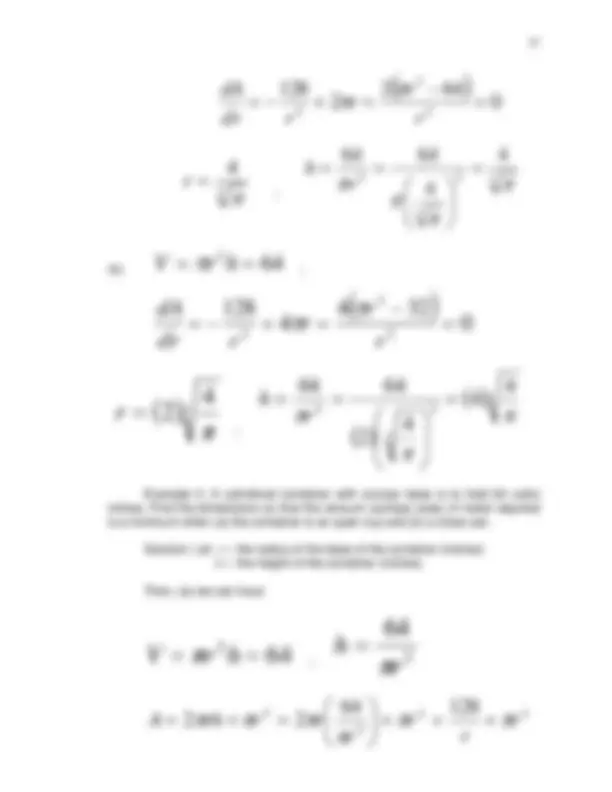
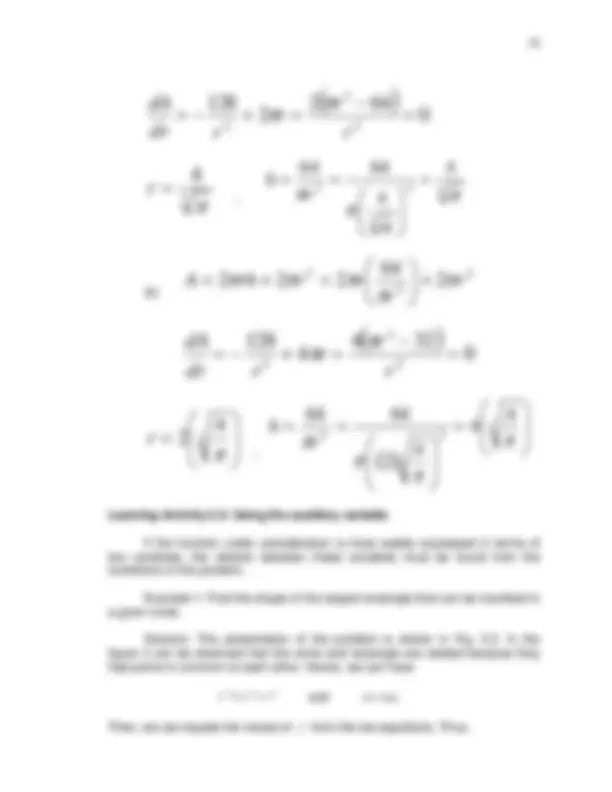
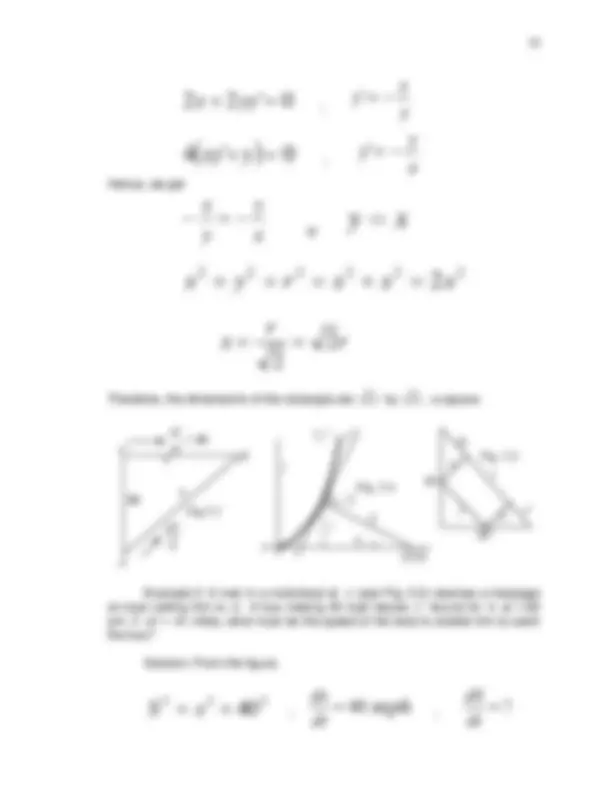
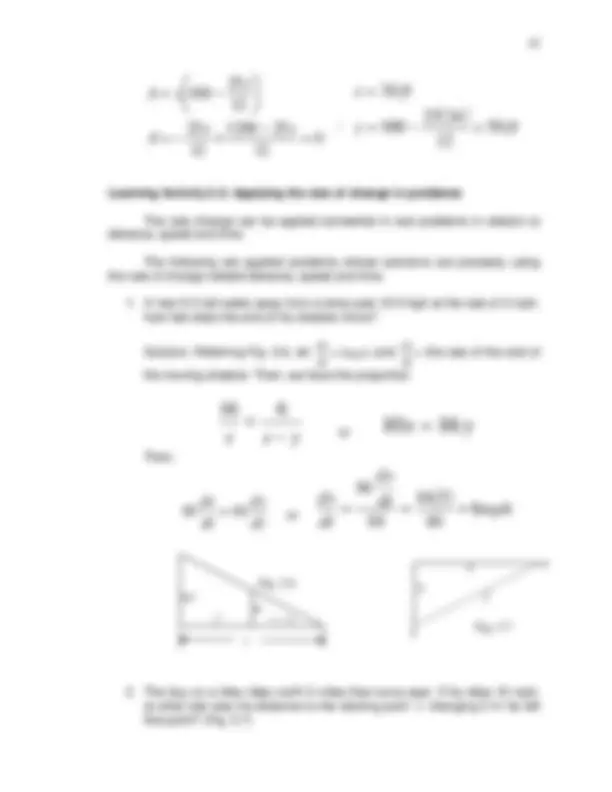
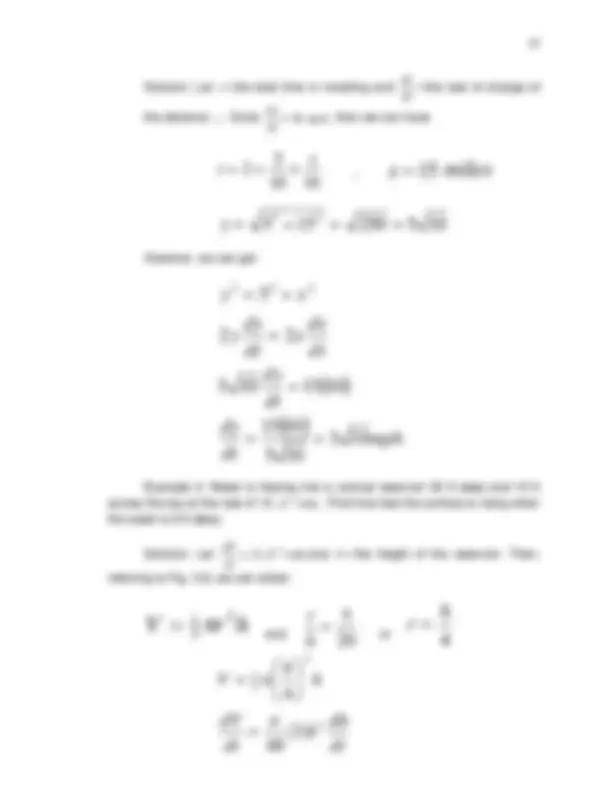
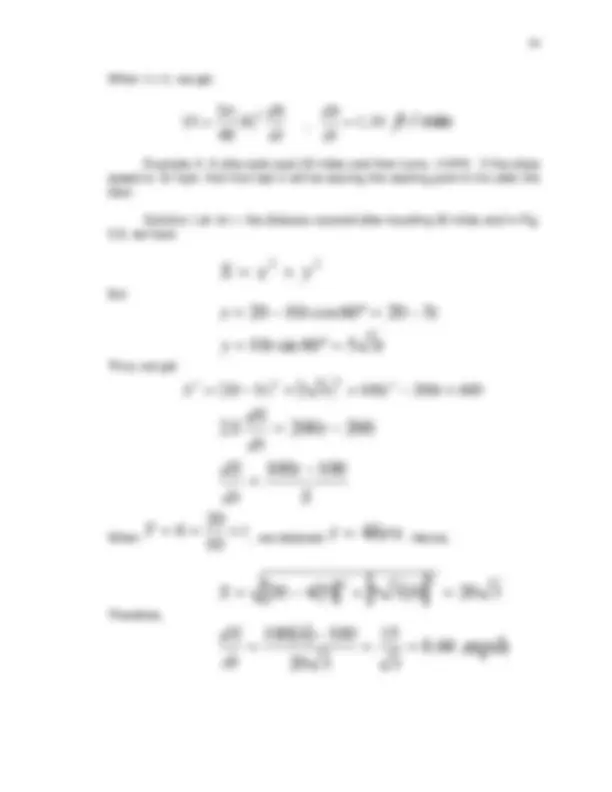
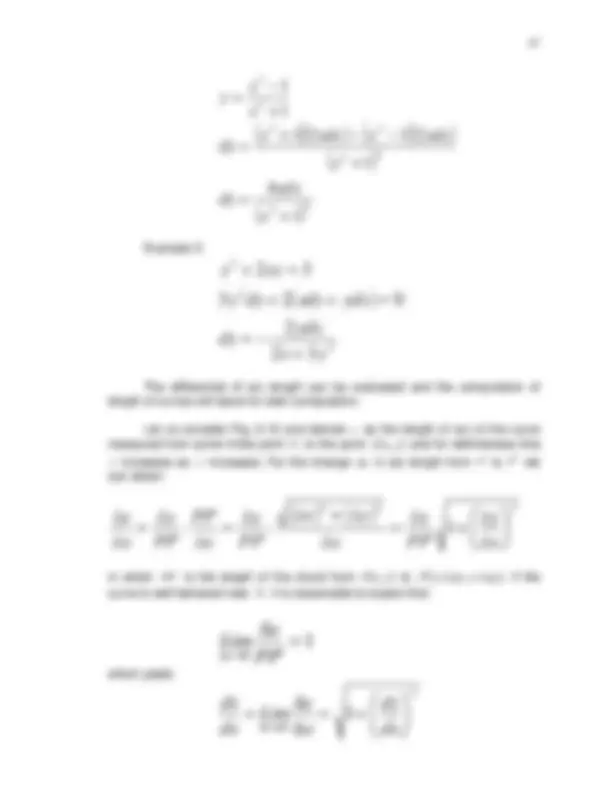
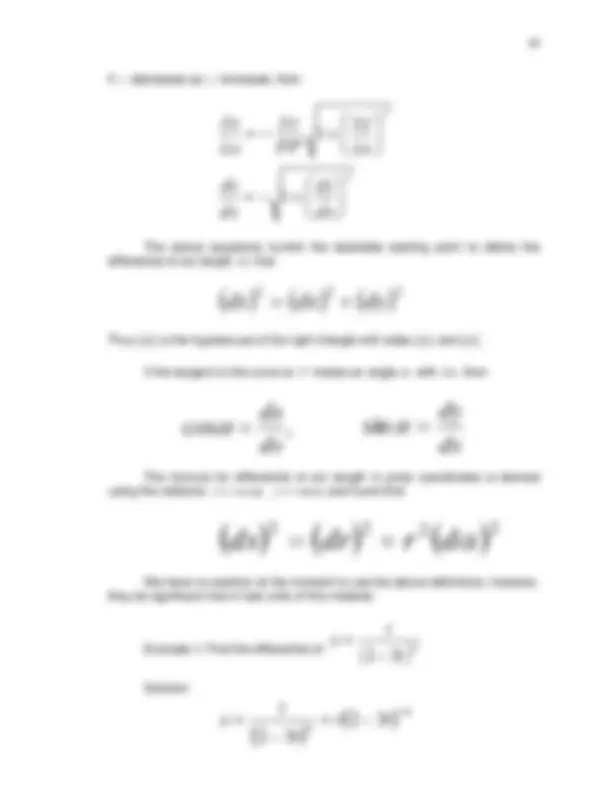
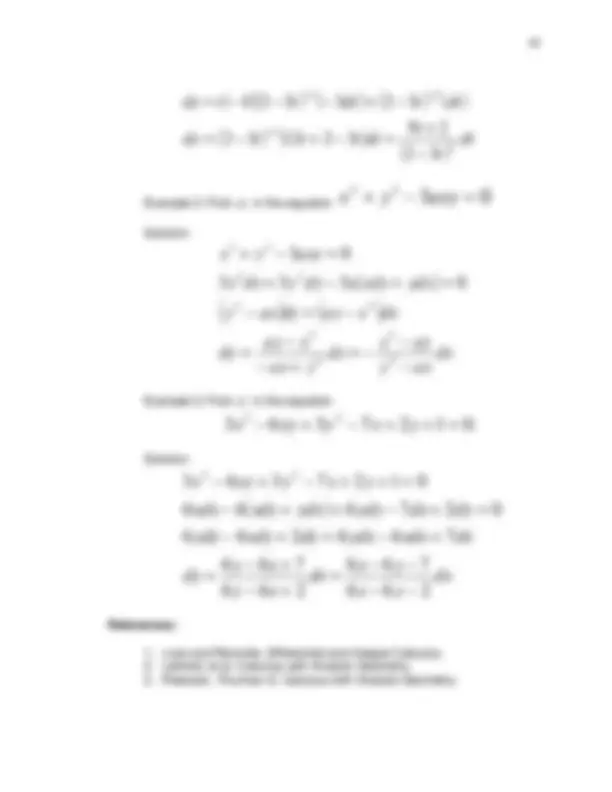


Study with the several resources on Docsity

Earn points by helping other students or get them with a premium plan


Prepare for your exams
Study with the several resources on Docsity

Earn points to download
Earn points by helping other students or get them with a premium plan
Community
Ask the community for help and clear up your study doubts
Discover the best universities in your country according to Docsity users
Free resources
Download our free guides on studying techniques, anxiety management strategies, and thesis advice from Docsity tutors
The applications of derivatives are: To determine the rate of change of a quantity with respect to another changing quantity. To determine maximum, minimum are saddle points of a function. To determine the concavity and convexity of a function.
Typology: Quizzes
1 / 15

This page cannot be seen from the preview
Don't miss anything!










Unit 5 – APPLICATION OF DERIVATIVES
General Objective of the Unit:
At the end of the unit the student should be able to comprehend with application of derivatives.
Specific Objectives:
At the end of the unit, the student is expected to:
Content:
Learning Activity 5.1: Applications of maxima and minima
The first derivative when vanishes assumes an extreme value, provided the derivative changes sign at that point. This result finds application in a great variety of problems, some of which will be considered here.
When the derivative is equated to zero, the critical values are obtained. In practice, the value that gives the desired maximum or minimum can often be selected at once by inspection.
Example 1: A sheet of paper for a poster contains 18 ft^2. The margins at
the top and bottom are 9 inches and at the sides 6 inches. What are the dimensions if the printed area will be maximum.
Solution: Let x the length of the poster (ft)
x
18 the width of the poster (ft)
1 2
18 3
2
18 3 (^1)
x dx
d
dx x x
d x dx
dA
0 2
18 3 2 x
x 2 3 ft
3 3 2 3
18 18 x
ft
Example 2: A cylindrical container with circular base is to hold 63 cubic inches. Find the dimensions so that the amount (surface area) of metal required is a minimum when (a) the container is an open cup and (b) a close can.
Solution: Let r the radius of the base of the container (inches) h the height of the container (inches)
(a) Then, we have
A 2 rh r
64
V r h ; 2
64
r
h
Hence,
Fig. 5.
Fig. 5.
0
2 64 2
128 2
3
2
r
r r dr r
3
4
r ;
(^23)
3
2
4
4
64 64
r
h
(b)
2 2
2 2
64 2 2 2 r r
A rh r r
0
4 32 4
128 2
3
2
r
r r dr r
3
4 2
r ;
^3 2
3
2
4 4
4 2
64 64
r
h
Learning Activity 5.2: Using the auxiliary variable
If the function under consideration is most readily expressed in terms of two variables, the relation between these variables must be found from the conditions of the problem.
Example 1: Find the shape of the largest rectangle that can be inscribed in a given circle.
Solution: The presentation of the problem is shown in Fig. 5.2. In the figure it can be observed that the circle and rectangle are related because they had points in common to each other. Hence, we can have
x^2 y^2 r^2 and A 4 xy
Then, we can equate the values of y ' from the two equations. Thus,
2 x 2 yy ' (^0) ; y
x y '
4 xy ' y (^0) ; x
y y '
Hence, we get
x
y
y
x or y x
x y r x x 2 x
r
r x 2 2
Therefore, the dimensions of the rectangle are 2 r by 2 r , a square.
Example 2: A man in a motorboat at A (see Fig. 5.3) receives a message at noon calling him to B. A bus making 40 mph leaves C bound for B at 1: pm. If AC 40 miles, what must be the speed of the boat to enable him to catch the bus?
Solution: From the figure,
2 2 2 S x (^40) ; ^40 dt
dx mph ; ? dt
dS
Fig.5.
Fig. 5.
Fig. 5.
y
x y 4
3 '
2 y
x y
5 '
5 5 2 2 13
2 2
2
2
2
3 10 2 0
3 4 20 0
3 5
(^2222)
3 3
2
2
S x y
x y
x
x x
x x
y
x
y
x
Example 4: A lot has the form of a right triangle, with perpendicular sides 60 and 80 ft long. Find the length and width of the largest rectangular building that can be erected, facing the hypotenuse.
Solution: Using Figure 5.5, let A the area of the building, so that we can get the hypotenuse equals 100:
100 y d d 1 ; A xy
Then,
; 4
3 x d
1
; 3
4 1
x d
Hence,
3
4
4
3 100
x x y ; 12
25 100
x y
Thus,
;
Learning Activity 5.2: Applying the rate of change in problems
The rate change can be applied somewhat in real problems in relation to distance, speed and time.
The following are applied problems whose solutions are precisely using the rate of change related distance, speed and time.
Solution: Referring Fig. 5.6, let mph dt
dy (^) 5 and dt
ds the rate of the end of
the moving shadow. Then, we have the proportion
s s y
16 6 or^10 s^ ^16 y
Then,
mph
dt
dy
dt
ds 8 10
165
10
16
Fig. 5.
Fig. 5.
When h 8 , we get
ft /min
Example 4: A ship sails east 20 miles and then turns N 30 W. If the ships speed is 10 mph, find how fast it will be leaving the starting point 6 hrs after the start.
Solution: Let 10 t the distance covered after traveling 20 miles and in Fig. 5.9, we have
But
y t t
x t t
10 sin 60 5 3
20 10 cos 60 20 5
Thus, we get
20 5 5 3 100 200 400 2 2 2 2
S
t
dt
dS
t dt
dS S
100 100
2 200 200
When T^ ^ t 10
20 6 , we obtained t^ ^4 hrs. Hence,
20 4 5 5 3 4 20 3
2 2 S
Therefore,
15
20 3
100 4 100
dt
dS mph
Learning Activity 5.2: Familiarizing the differentials
Consider the interval in which a curve relating x and y has slope y '.
x in the value of x change y to some amount y .In the figures P ' is the point
must satisfy two requirements: First it must be possible to prove that the difference between the approximation and y can be made small by taking x
sufficiently small; second, the approximation must be easy to compute.
Again, in the figures the tangent line at P intersects the ordinate through P ' at point R. The length SR is an approximation to SP ' y for small x .At P
the slope is. PS
SR Since (^) PS x ,so we obtain
SR y ' x.
Hence the second requirement is satisfied by SR.
The difference between SR and SP 'is given by
P ' R SR SP ' y ' x y.
Fig. 5.
Fig. 5.
Fig. 5.10 Fig. 5.
2 2
2 2
2 2
2
2
Example 3:
2
2
3
2 3
2
3 2 0
2 3
x y
ydx dy
y dy xdy ydx
y xy
The differential of arc length can be evaluated and the computation of length of curves will leave for later computation.
Let us consider Fig. 6.12 and denote s as the length of arc of the curve
s increases as x increases. For the change s in arc length from P to P ' we can obtain
2 2 2
1 ' '
'
'
x
y
PP
s
x
x y
PP
s
x
PP
PP
s
x
s
curve is well behaved near P , it is reasonable to expect that
1 (^0) '
PP
s Lim x
which yields
2
0
(^1)
dx
dy
x
s Lim dx
ds
x
If x decreases as x increases, then
2
2
1
1 '
dx
dy
dx
ds
x
y
PP
s
x
s
The above equations furnish the desirable starting point to define the differential of arc length ds that
Thus ds is the hypotenuse of the right triangle with sides dx and dy.
The formula for differential of arc length in polar coordinates is derived using the relations x r cos , y r sin and found that
2 2 2 2
We have no position at the moment to use the above definitions, however, they do significant role in late units of this material.
Example 1: Find the differential of
4 2 3 t
t x
Solution:
4 4 2 3 2 3
t t t
t x